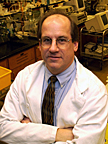December 21, 2005
SIUC research aids pharmaceutical companies
CARBONDALE, Ill. -- Pharmaceutical companies will soon have a new tool to help them find and develop new drugs.Using technology refined at Southern Illinois University Carbondale, two small Minnesota firms are devising an analytical instrument based on technology that is so sensitive it can detect just a few molecules of virtually any chemical compound in the world. Such sensitivity would prove useful to the drug industry in everything from pinpointing the components of newly discovered plants to assaying the purity of a particular formula to monitoring the length of time a given drug stays in the bloodstream.
Made by Fluid Measurement Technologies Inc., and Quant Technologies, the equipment should reach the market within two years, said John A. Koropchak, the SIUC chemist whose condensation nucleation light scattering detection technique underpins the new system.
Because it can detect a limitless number of chemicals and will probably cost less than other detection systems now available, Koropchak predicts great demand for the product.
"We have worked closely with contacts at major pharmaceutical companies like Eli Lilly and Pfizer to determine what they need from this technology, and we know there are companies already budgeting funds to buy it," he said.
The National Institutes of Health is supporting the effort with a $1.2 million grant through its Small Business Innovative Research program, designed to turn federally funded scientific discoveries into commercial products.
Scientists first began working with the process that drives the new technique in the 1800s. Although it takes place in a laboratory, not in the sky, condensation nucleation somewhat resembles cloud "seeding," where chemicals dropped by plane into a cloud serve as nuclei for water vapor molecules. The vapor molecules condense upon the chemicals until the whole shebang has grown from molecule- to droplet-sized.
"In condensation nucleation, particles as small as a few nanometers — the size of a single molecule of a small protein — can be grown to droplets that are large enough to be detected even with the naked eye," Koropchak said.
"This growth involves huge gains in mass — approximately the same as the difference between a grain of sand and the Statue of Liberty. Just as it's easier to see the State of Liberty than a grain of sand, the condensation nucleation process allows us to detect small quantities of material more easily."
But knowing "how much" is different from knowing "of what." That's where Koropchak's research comes in.
"Our twist was to combine our detector with a chemical separation system to get information on what kind of substances are present," he said.
Koropchak and Fluid Measurement Technologies President David B. Blackford settled on high performance liquid chromatography as the separation system of choice.
"It's widely used in a lot of industries, but particularly in the pharmaceutical industry," Koropchak said.
"I go to labs in some of these companies and see huge rooms of them, one after another — dozens and dozens of them."
That combination of "how much" and "what" provides unbeatable power.
"In addition to being able to detect very tiny amounts of substances, this technology is also ‘universal' — you can get a response for almost anything," Koropchak said.
"Most detection systems can detect some compounds but not all. Even those that are ‘universal' can only detect substances at fairly high concentrations. The pharmaceutical industry, among others, has substantial needs for detection of every sample component. And the ability to analyze hard-to-detect substances such as lipids and carbohydrates could provide a powerful tool for drug discovery."
Fluid Measurement Technologies representatives delivered prototypes of an earlier version of the system during the project's first phase. Newer versions should arrive soon. During January and February, Koropchak will test them on three different classes of compounds with which he has worked extensively.
"We know what their performance should be, so if there's a problem, we can quickly identify it," he said. "We've pretty well got this down, so we should be able to test a single prototype within three weeks or so."
These prototypes likely will be smaller than those Koropchak previously tested — roughly the size of an early-generation VCR.
"There was some concern about the ‘footprint' and how much space it takes up in a laboratory," Koropchak said.
They also will condense water rather than a form of alcohol called butanol, a change that his research suggests will boost the equipment's detection ability tenfold. Water also costs less and, while butanol is not considered a risky compound, "There's nothing safer than water!" Koropchak noted.
Based on his results, FMT engineers may redesign the prototype, incorporating feedback and suggestions from potential customers, before turning out the final product.
In the meantime, Koropchak, who also is SIUC's vice chancellor for research, will be working on what he calls "the next version of instrumentation," one that focuses on coupling his detector with other chemical analysis systems that might, for example, be used in monitoring the environment or medical equipment.
"Because it is a universal system, the number of applications is almost unlimited," he said.
Leading in research, scholarly and creative activities is among the goals of Southern at 150: Building Excellence Through Commitment, the blueprint the University is following as it approaches its 150th anniversary in 2019.

